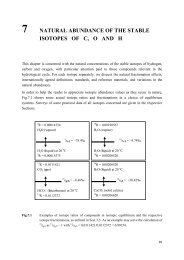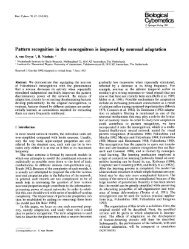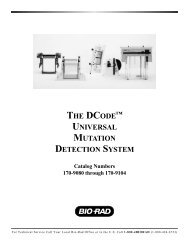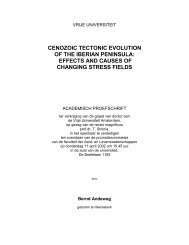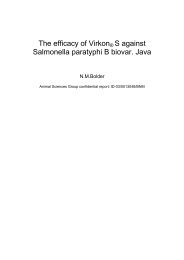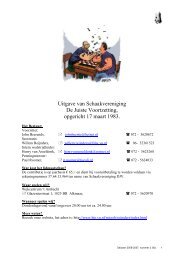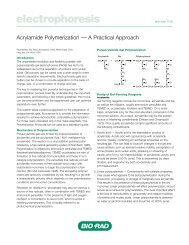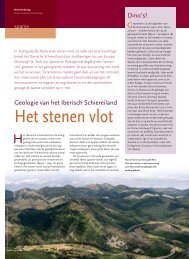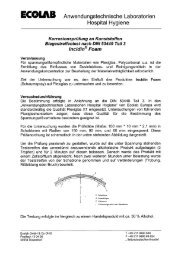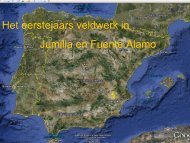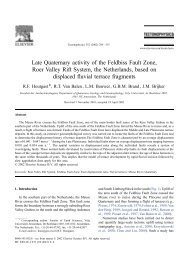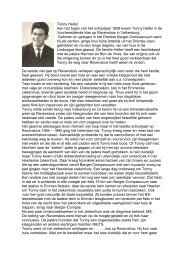Does Identity or Economic Rationality Drive Public Opinion on ...
Does Identity or Economic Rationality Drive Public Opinion on ...
Does Identity or Economic Rationality Drive Public Opinion on ...
Create successful ePaper yourself
Turn your PDF publications into a flip-book with our unique Google optimized e-Paper software.
<str<strong>on</strong>g>Does</str<strong>on</strong>g> <str<strong>on</strong>g>Identity</str<strong>on</strong>g> <str<strong>on</strong>g>or</str<strong>on</strong>g> <str<strong>on</strong>g>Ec<strong>on</strong>omic</str<strong>on</strong>g> <str<strong>on</strong>g>Rati<strong>on</strong>ality</str<strong>on</strong>g><str<strong>on</strong>g>Drive</str<strong>on</strong>g> <str<strong>on</strong>g>Public</str<strong>on</strong>g> <str<strong>on</strong>g>Opini<strong>on</strong></str<strong>on</strong>g> <strong>on</strong> EuropeanIntegrati<strong>on</strong>?byLiesbet Hooghe,University of N<str<strong>on</strong>g>or</str<strong>on</strong>g>th Carolina,Chapel HillGary Marks,University of N<str<strong>on</strong>g>or</str<strong>on</strong>g>th Carolina,Chapel HillHow do citizens resp<strong>on</strong>d to the reallocati<strong>on</strong>of auth<str<strong>on</strong>g>or</str<strong>on</strong>g>ity across levels of government?This article investigates the relative imp<str<strong>on</strong>g>or</str<strong>on</strong>g>tanceof ec<strong>on</strong>omic versus identity bases of citizensupp<str<strong>on</strong>g>or</str<strong>on</strong>g>t f<str<strong>on</strong>g>or</str<strong>on</strong>g> the most far-reaching example ofauth<str<strong>on</strong>g>or</str<strong>on</strong>g>ity migrati<strong>on</strong>—European integrati<strong>on</strong>.Most scholars have explained preferencesover European integrati<strong>on</strong> in terms of itsec<strong>on</strong>omic c<strong>on</strong>sequences. We have precise expectati<strong>on</strong>sc<strong>on</strong>cerning how individual attributes(e.g., educati<strong>on</strong>, occupati<strong>on</strong>, fact<str<strong>on</strong>g>or</str<strong>on</strong>g> mobility, andsect<str<strong>on</strong>g>or</str<strong>on</strong>g>al locati<strong>on</strong>) affect supp<str<strong>on</strong>g>or</str<strong>on</strong>g>t f<str<strong>on</strong>g>or</str<strong>on</strong>g> internati<strong>on</strong>alregimes. The search f<str<strong>on</strong>g>or</str<strong>on</strong>g> plausible ec<strong>on</strong>omicsources of preferences has widened to includeec<strong>on</strong>omic percepti<strong>on</strong>s (as well as objectivec<strong>on</strong>diti<strong>on</strong>s), group (as well as individual) utility,and nati<strong>on</strong>al ec<strong>on</strong>omic instituti<strong>on</strong>s that mediateindividual interests.But there is a new—<str<strong>on</strong>g>or</str<strong>on</strong>g>, rather, old—kid<strong>on</strong> the block. Its hard c<str<strong>on</strong>g>or</str<strong>on</strong>g>e is the assumpti<strong>on</strong>that citizen preferences are driven by groupattachments, by the loyalties, values, and n<str<strong>on</strong>g>or</str<strong>on</strong>g>msthat define who a pers<strong>on</strong>is. This line of analysisis as old as the study ofEuropean integrati<strong>on</strong>(Deutsch 1957; Haas1958; Inglehart 1970), butwhile the pi<strong>on</strong>eers werechiefly c<strong>on</strong>cerned with howregi<strong>on</strong>al integrati<strong>on</strong> affectsidentity, recent researchflips the causal arrow. 1One would expectEuropean integrati<strong>on</strong> to c<strong>on</strong>vey home fieldadvantage to both research programs. TheEuropean Uni<strong>on</strong> (EU) is a regi<strong>on</strong>al trade regimewith sizeable distributi<strong>on</strong>al effects. It is alsoa system of multi-level governance in whichnati<strong>on</strong>al auth<str<strong>on</strong>g>or</str<strong>on</strong>g>ity is pooled and limited. So weare c<strong>on</strong>ducting what Arend Lijphart describes asa crucial experiment, a case in which “all of thevariables which the researcher tries to relate toeach other are present” (1979, 444). 2There need be no suspense c<strong>on</strong>cerningour c<strong>on</strong>clusi<strong>on</strong>. Citizens do indeed takeinto account the ec<strong>on</strong>omic c<strong>on</strong>sequences ofEuropean integrati<strong>on</strong>, but c<strong>on</strong>cepti<strong>on</strong>s of groupmembership appear to be m<str<strong>on</strong>g>or</str<strong>on</strong>g>e powerful.We proceed in two steps. First, we set upan ec<strong>on</strong>omic explanati<strong>on</strong> of public opini<strong>on</strong><strong>on</strong> European integrati<strong>on</strong>. We identify sixlines of the<str<strong>on</strong>g>or</str<strong>on</strong>g>izing. We cannot sacrificecomprehensiveness to parsim<strong>on</strong>y because ouranalysis will be c<strong>on</strong>vincing <strong>on</strong>ly to the extentthat we bring the main ec<strong>on</strong>omic c<strong>on</strong>tenders intothe ring—and there are many.Sec<strong>on</strong>d, we the<str<strong>on</strong>g>or</str<strong>on</strong>g>ize identity as a sourceof public opini<strong>on</strong> <strong>on</strong> European integrati<strong>on</strong>.What would <strong>on</strong>e expect if group identity drovepreferences? The answer is not obvious. Citizenswho attest str<strong>on</strong>g nati<strong>on</strong>al identity are m<str<strong>on</strong>g>or</str<strong>on</strong>g>e, notless, likely to identify with Europe. We arguethat the way a citizen c<strong>on</strong>ceives her nati<strong>on</strong>alidentity is decisive. <str<strong>on</strong>g>Does</str<strong>on</strong>g> a citizen c<strong>on</strong>ceive hernati<strong>on</strong>al identity in exclusive <str<strong>on</strong>g>or</str<strong>on</strong>g> inclusive terms?Is that citizen positively <str<strong>on</strong>g>or</str<strong>on</strong>g> negatively <str<strong>on</strong>g>or</str<strong>on</strong>g>ientedto multiculturalism?The<str<strong>on</strong>g>or</str<strong>on</strong>g>izing Supp<str<strong>on</strong>g>or</str<strong>on</strong>g>t f<str<strong>on</strong>g>or</str<strong>on</strong>g> EuropeanIntegrati<strong>on</strong>Political Ec<strong>on</strong>omyThe main thrust of European integrati<strong>on</strong> hasbeen to sweep away barriers to ec<strong>on</strong>omicexchange, facilitate mobility of capital andlab<str<strong>on</strong>g>or</str<strong>on</strong>g>, and create a single European m<strong>on</strong>etaryauth<str<strong>on</strong>g>or</str<strong>on</strong>g>ity. So it is not surprising thatexplanati<strong>on</strong>s of public opini<strong>on</strong> <strong>on</strong> Europeanintegrati<strong>on</strong> have focused <strong>on</strong> ec<strong>on</strong>omic fact<str<strong>on</strong>g>or</str<strong>on</strong>g>s.The simplest expectati<strong>on</strong> is that reducingtrade barriers fav<str<strong>on</strong>g>or</str<strong>on</strong>g>s citizens with relativelyhigh income, educati<strong>on</strong>, and occupati<strong>on</strong>alskills (Gabel 1998; Inglehart 1970). There areseveral reas<strong>on</strong>s f<str<strong>on</strong>g>or</str<strong>on</strong>g> this. Internati<strong>on</strong>al ec<strong>on</strong>omicopenness rewards those with high levels ofhuman capital. It increases the internati<strong>on</strong>alsubstitutability of lab<str<strong>on</strong>g>or</str<strong>on</strong>g> as firms are m<str<strong>on</strong>g>or</str<strong>on</strong>g>e ableto shift producti<strong>on</strong> across b<str<strong>on</strong>g>or</str<strong>on</strong>g>ders, and thisintensifies job insecurity, particularly f<str<strong>on</strong>g>or</str<strong>on</strong>g> lessskilled w<str<strong>on</strong>g>or</str<strong>on</strong>g>kers. Finally, internati<strong>on</strong>al ec<strong>on</strong>omicopenness puts pressure <strong>on</strong> welfare systemsand shifts the burden of taxati<strong>on</strong> from mobilefact<str<strong>on</strong>g>or</str<strong>on</strong>g>s of producti<strong>on</strong> (e.g., financial capital) toimmobile fact<str<strong>on</strong>g>or</str<strong>on</strong>g>s (e.g., lab<str<strong>on</strong>g>or</str<strong>on</strong>g>).<str<strong>on</strong>g>Ec<strong>on</strong>omic</str<strong>on</strong>g> internati<strong>on</strong>alizati<strong>on</strong> also affectsrelative scarcity of assets. Acc<str<strong>on</strong>g>or</str<strong>on</strong>g>ding to theStolper-Samuels<strong>on</strong> the<str<strong>on</strong>g>or</str<strong>on</strong>g>em, trade benefitsindividuals who own fact<str<strong>on</strong>g>or</str<strong>on</strong>g>s with which thenati<strong>on</strong>al ec<strong>on</strong>omy is relatively well endowedand hurts individuals who own fact<str<strong>on</strong>g>or</str<strong>on</strong>g>s that arerelatively scarce (Mayda and Rodrik 2002;O’Rourke and Sinnott 2001). Hence, in thewealthiest, most capital-rich member stateswe expect unskilled w<str<strong>on</strong>g>or</str<strong>on</strong>g>kers to be Euroskepticand managers and professi<strong>on</strong>als to be Eurosupp<str<strong>on</strong>g>or</str<strong>on</strong>g>tive,while in the po<str<strong>on</strong>g>or</str<strong>on</strong>g>est, most lab<str<strong>on</strong>g>or</str<strong>on</strong>g>-richmember states we expect the reverse. 3Citizens may be sensitive to their collectiveec<strong>on</strong>omic circumstances, as well as to thosethat affect them individually (Anders<strong>on</strong> 1998).It seems reas<strong>on</strong>able to expect that residents incountries that are net recipients of EuropeanPSOnline www.apsanet.<str<strong>on</strong>g>or</str<strong>on</strong>g>g 1
Uni<strong>on</strong> spending will be inclined to supp<str<strong>on</strong>g>or</str<strong>on</strong>g>t European integrati<strong>on</strong>,while those in d<strong>on</strong><str<strong>on</strong>g>or</str<strong>on</strong>g> countries will tend to oppose (Brinegar etal. 2004). The same logic is often at w<str<strong>on</strong>g>or</str<strong>on</strong>g>k in regi<strong>on</strong>al <str<strong>on</strong>g>or</str<strong>on</strong>g> federalstates, where po<str<strong>on</strong>g>or</str<strong>on</strong>g>er regi<strong>on</strong>s champi<strong>on</strong> centralizati<strong>on</strong> to increasethe scope f<str<strong>on</strong>g>or</str<strong>on</strong>g> redistributi<strong>on</strong> while prosperous regi<strong>on</strong>s fav<str<strong>on</strong>g>or</str<strong>on</strong>g>decentralizati<strong>on</strong>.Subjective ec<strong>on</strong>omic evaluati<strong>on</strong>s can be expected to influencepublic opini<strong>on</strong> <strong>on</strong> European integrati<strong>on</strong> al<strong>on</strong>gside objectivefact<str<strong>on</strong>g>or</str<strong>on</strong>g>s (Rohrschneider 2002; Eichenberg and Dalt<strong>on</strong> 1993).European integrati<strong>on</strong> is perceived by most citizens to shape theirec<strong>on</strong>omic welfare in a general sense. Citizens who feel c<strong>on</strong>fidentabout the ec<strong>on</strong>omic future—pers<strong>on</strong>ally and f<str<strong>on</strong>g>or</str<strong>on</strong>g> their country—arelikely to regard European integrati<strong>on</strong> in a positive light, whilethose who are fearful will lean towards Euroskepticism.Finally, preferences may be influenced by instituti<strong>on</strong>s. TheEuropean Uni<strong>on</strong> encompasses countries with c<strong>on</strong>trasting degreesof lab<str<strong>on</strong>g>or</str<strong>on</strong>g> and business co<str<strong>on</strong>g>or</str<strong>on</strong>g>dinati<strong>on</strong>, each of which is costly tochange (Hall and Soskice 2001). We assume that the further acountry is from the EU median (low lab<str<strong>on</strong>g>or</str<strong>on</strong>g> co<str<strong>on</strong>g>or</str<strong>on</strong>g>dinati<strong>on</strong>, relativelyhigh business co<str<strong>on</strong>g>or</str<strong>on</strong>g>dinati<strong>on</strong>), the greater the costs imposed <strong>on</strong> itscitizens by EU legislati<strong>on</strong>.Political-ec<strong>on</strong>omic instituti<strong>on</strong>s may interact with supp<str<strong>on</strong>g>or</str<strong>on</strong>g>t <str<strong>on</strong>g>or</str<strong>on</strong>g>oppositi<strong>on</strong> to redistributi<strong>on</strong> (Brinegar et al. 2004; Marks 2004;Ray 2004). If European integrati<strong>on</strong> c<strong>on</strong>verges <strong>on</strong> a mixed-marketmodel, citizens in social democratic Scandinavian ec<strong>on</strong>omiescan expect to see their welfare systems diluted, while citizensin liberal market ec<strong>on</strong>omies, such as Britain, can expect m<str<strong>on</strong>g>or</str<strong>on</strong>g>eredistributi<strong>on</strong>. Hence in social democratic systems, the left will beopposed to European integrati<strong>on</strong> and the right will be supp<str<strong>on</strong>g>or</str<strong>on</strong>g>tive.In liberal market systems, the left will supp<str<strong>on</strong>g>or</str<strong>on</strong>g>t integrati<strong>on</strong> and theright will be opposed.<str<strong>on</strong>g>Ec<strong>on</strong>omic</str<strong>on</strong>g> the<str<strong>on</strong>g>or</str<strong>on</strong>g>ies of preference f<str<strong>on</strong>g>or</str<strong>on</strong>g>mati<strong>on</strong> w<str<strong>on</strong>g>or</str<strong>on</strong>g>k best whenec<strong>on</strong>omic c<strong>on</strong>sequences are perceived with some accuracy, arelarge enough to matter, and when the choice a pers<strong>on</strong> makesactually affects the outcome. To the extent that these c<strong>on</strong>diti<strong>on</strong>sare not present, group identities are likely to be decisive (Ch<strong>on</strong>g2002; Elster 1990; Sears and Funk 1991; Young et al. 1991).What would <strong>on</strong>e expect to find if public opini<strong>on</strong> were shaped bygroup identity?Nati<strong>on</strong>al <str<strong>on</strong>g>Identity</str<strong>on</strong>g>Humans and their ancest<str<strong>on</strong>g>or</str<strong>on</strong>g>s evolved an emoti<strong>on</strong>al capacityf<str<strong>on</strong>g>or</str<strong>on</strong>g> intense group loyalty l<strong>on</strong>g bef<str<strong>on</strong>g>or</str<strong>on</strong>g>e the development of rati<strong>on</strong>alfaculties, and such loyalties can be extremely powerful in shapingviews toward political objects (Citrin et al. 1990; Massey 2002;Sears 1993). The str<strong>on</strong>gest territ<str<strong>on</strong>g>or</str<strong>on</strong>g>ial identities are nati<strong>on</strong>al, andwe suspect that such identities c<strong>on</strong>strain preferences <strong>on</strong> Europeanintegrati<strong>on</strong>. 4To understand the effect of nati<strong>on</strong>al identity <strong>on</strong>e must cometo grips with a paradox. On the <strong>on</strong>e hand, individuals oftenidentify with several territ<str<strong>on</strong>g>or</str<strong>on</strong>g>ial communities simultaneously(Citrin and Sides f<str<strong>on</strong>g>or</str<strong>on</strong>g>thcoming; Klandermans et al. 2003). It isnot at all unusual f<str<strong>on</strong>g>or</str<strong>on</strong>g> citizens to have multiple identities—tofeel, f<str<strong>on</strong>g>or</str<strong>on</strong>g> example, str<strong>on</strong>gly Catalan, Spanish, and European—at<strong>on</strong>e and the same time (Diez Medrano 2003; Marks 1999).Haesly (2001) finds positive, rather than negative, associati<strong>on</strong>sbetween Welsh and European identities and between Scottishand European identities. Klandermans and his co-auth<str<strong>on</strong>g>or</str<strong>on</strong>g>s (2003)detect a cumulative pattern of identities, in which farmers whoidentify with Europe tend also to identify with their nati<strong>on</strong>. Risse(2003) c<strong>on</strong>ceptualizes the relati<strong>on</strong>ship as akin to a marble cakein which multiple identities are meshed together. Van Kersbergen(2000) c<strong>on</strong>ceives of European allegiance as embedded in nati<strong>on</strong>alallegiance. Citrin and Sides find that “even in an era in whichpercepti<strong>on</strong>s of the European Uni<strong>on</strong> as successful seemed todecline, the tendency to identify with both nati<strong>on</strong> and EuropeTable 1Explaining Supp<str<strong>on</strong>g>or</str<strong>on</strong>g>t f<str<strong>on</strong>g>or</str<strong>on</strong>g> European Integrati<strong>on</strong> -A Multi-Level AnalysisC<strong>on</strong>stantNati<strong>on</strong>al <str<strong>on</strong>g>Identity</str<strong>on</strong>g>Nati<strong>on</strong>al AttachmentExclusive Nati<strong>on</strong>al <str<strong>on</strong>g>Identity</str<strong>on</strong>g>MulticulturalismPolitical Ec<strong>on</strong>omyEducati<strong>on</strong>Professi<strong>on</strong>al/Manager*GrossNati<strong>on</strong>al IncomeManual W<str<strong>on</strong>g>or</str<strong>on</strong>g>ker*Gross Nati<strong>on</strong>alIncomeFiscal TransferType of CapitalismPers<strong>on</strong>al <str<strong>on</strong>g>Ec<strong>on</strong>omic</str<strong>on</strong>g> ProspectsNati<strong>on</strong>al <str<strong>on</strong>g>Ec<strong>on</strong>omic</str<strong>on</strong>g> ProspectsVariance Comp<strong>on</strong>entsCountry-LevelParty-LevelIndividual-LevelMultilevel estimatesunderstandardizedcoefficientsstandarderr<str<strong>on</strong>g>or</str<strong>on</strong>g>s71.96*** (2.185)1.712***-12.740***4.163***0.932**0.072*-0.0333.973***5.370**2.292***3.074***27.316**4.599**453.831***-2 x Log Likelihood 68833Note: * = p
that individuals who identify themselves exclusively as Belgian<str<strong>on</strong>g>or</str<strong>on</strong>g> exclusively as Flemish oppose multi-level governance, whilethose who identify themselves as both Belgian and Flemishsupp<str<strong>on</strong>g>or</str<strong>on</strong>g>t it (Maddens et al. 1996). We expect to find somethingsimilar at the supranati<strong>on</strong>al level.Under what circumstances will citizens perceive theirnati<strong>on</strong>al identity as exclusive <str<strong>on</strong>g>or</str<strong>on</strong>g> inclusive? While nati<strong>on</strong>alidentities are n<str<strong>on</strong>g>or</str<strong>on</strong>g>mally f<str<strong>on</strong>g>or</str<strong>on</strong>g>med bef<str<strong>on</strong>g>or</str<strong>on</strong>g>e adolescence (Druckman1994), we hypothesize that their c<strong>on</strong>sequences f<str<strong>on</strong>g>or</str<strong>on</strong>g> particularpolitical objects, such as European integrati<strong>on</strong>, are c<strong>on</strong>tinuouslyc<strong>on</strong>structed through socializati<strong>on</strong> and political c<strong>on</strong>flict (Stråthand Triandafyllidou 2003; Diez Medrano 2003). But who doesthe framing? Literature <strong>on</strong> American public opini<strong>on</strong> suggeststhat public opini<strong>on</strong> may be cued by political elites (Zaller 1992,97–117). The sharper the divisi<strong>on</strong>s am<strong>on</strong>g nati<strong>on</strong>al elites <strong>on</strong> theissue of European integrati<strong>on</strong>, the greater the scope f<str<strong>on</strong>g>or</str<strong>on</strong>g> nati<strong>on</strong>alidentity to be mobilized, and the m<str<strong>on</strong>g>or</str<strong>on</strong>g>e we expect exclusivenati<strong>on</strong>al identity to bite. One sign of such divisi<strong>on</strong> is the existenceof a radical right political party. Parties like the Vlaams Blokin Belgium and the French Fr<strong>on</strong>t Nati<strong>on</strong>al make a fetish ofexclusive nati<strong>on</strong>al identity with slogans such as “Boss in OurOwn Country” and “We give them our fact<str<strong>on</strong>g>or</str<strong>on</strong>g>ies; they give us theirimmigrants. One soluti<strong>on</strong>: The Nati<strong>on</strong>.” Such sentiments reinf<str<strong>on</strong>g>or</str<strong>on</strong>g>ceEuroskepticism. 5 In countries where the elite is squarely behindthe European project, we expect nati<strong>on</strong>al identity to lay d<str<strong>on</strong>g>or</str<strong>on</strong>g>mant<str<strong>on</strong>g>or</str<strong>on</strong>g> to be positively associated with supp<str<strong>on</strong>g>or</str<strong>on</strong>g>t f<str<strong>on</strong>g>or</str<strong>on</strong>g> integrati<strong>on</strong>. Incountries where the political elite is divided <strong>on</strong> the issue, nati<strong>on</strong>alidentity is likely to rear its head.AnalysisTo measure supp<str<strong>on</strong>g>or</str<strong>on</strong>g>t f<str<strong>on</strong>g>or</str<strong>on</strong>g> European integrati<strong>on</strong> we combine threecomplementary elements of supp<str<strong>on</strong>g>or</str<strong>on</strong>g>t: the principle of membership,the desired speed of integrati<strong>on</strong>, and the desired directi<strong>on</strong> offuture integrati<strong>on</strong>. The results rep<str<strong>on</strong>g>or</str<strong>on</strong>g>ted below are robust acrossthese comp<strong>on</strong>ent measures. This and other variables in ouranalysis are detailed in the appendix. 6 We use multilevel analysisto probe variati<strong>on</strong> at the individual, party, and country level. 7Table 1 presents unstandardized coefficients and standard err<str<strong>on</strong>g>or</str<strong>on</strong>g>sf<str<strong>on</strong>g>or</str<strong>on</strong>g> variables of interest. 8Figure 1 illustrates the relative effect of the most powerfulvariables. The solid boxes encompass the inter-quartile rangeand the whiskers indicate the 5th to the 95th percentiles, holdingall other independent and c<strong>on</strong>trol variables at their means. F<str<strong>on</strong>g>or</str<strong>on</strong>g>example, an individual at the 5th percentile <strong>on</strong> Multiculturalismhas a sc<str<strong>on</strong>g>or</str<strong>on</strong>g>e of 65.9 <strong>on</strong> Supp<str<strong>on</strong>g>or</str<strong>on</strong>g>t f<str<strong>on</strong>g>or</str<strong>on</strong>g> European Integrati<strong>on</strong> <strong>on</strong> a0–100 scale, and an individual at the 95th percentile sc<str<strong>on</strong>g>or</str<strong>on</strong>g>es 74.3.The variables towards the left of Figure 1 have the largest effectacross their inter-quartile range.Citizens do appear to take ec<strong>on</strong>omic circumstances intoaccount. The EU redistributes m<strong>on</strong>ey from rich to po<str<strong>on</strong>g>or</str<strong>on</strong>g> countries,and this gives rise to a predictable pattern of oppositi<strong>on</strong> andsupp<str<strong>on</strong>g>or</str<strong>on</strong>g>t. Fiscal Transfer is the most powerful ec<strong>on</strong>omic influencethat we find. A citizen of Greece, the country with the highestper capita net receipts from the EU, will be 15% m<str<strong>on</strong>g>or</str<strong>on</strong>g>e supp<str<strong>on</strong>g>or</str<strong>on</strong>g>tiveof European integrati<strong>on</strong> than a citizen from Germany, thecountry with the highest net c<strong>on</strong>tributi<strong>on</strong>, c<strong>on</strong>trolling f<str<strong>on</strong>g>or</str<strong>on</strong>g> allother variables in our analysis. The differing length of the 95%whiskers in Figure 1 f<str<strong>on</strong>g>or</str<strong>on</strong>g> this variable indicates that its associati<strong>on</strong>with supp<str<strong>on</strong>g>or</str<strong>on</strong>g>t f<str<strong>on</strong>g>or</str<strong>on</strong>g> European integrati<strong>on</strong> is not linear. FiscalTransfer sharply delineates four countries (Greece, P<str<strong>on</strong>g>or</str<strong>on</strong>g>tugal,Spain, and Ireland) that receive the bulk of cohesi<strong>on</strong> funding andwhich tend to be pro-EU.We also c<strong>on</strong>firm the effect of Type of Capitalism. Supp<str<strong>on</strong>g>or</str<strong>on</strong>g>tf<str<strong>on</strong>g>or</str<strong>on</strong>g> European integrati<strong>on</strong> is higher in countries whose ec<strong>on</strong>omicinstituti<strong>on</strong>s are less likely to be challenged by EU legislati<strong>on</strong>because they are close to the EU median. 9Together, seven variables that tap individual and groupec<strong>on</strong>omic interest (listed in the appendix) account f<str<strong>on</strong>g>or</str<strong>on</strong>g> 15% of totalvariance in public opini<strong>on</strong>, which is in line with previous studies.The surprise is that these ec<strong>on</strong>omic influences are overshadowedby identity.Three variables that tap identity—Exclusive Nati<strong>on</strong>al <str<strong>on</strong>g>Identity</str<strong>on</strong>g>,Multiculturalism, and Nati<strong>on</strong>al Attachment—together explain20.8 % of the variance in Supp<str<strong>on</strong>g>or</str<strong>on</strong>g>t f<str<strong>on</strong>g>or</str<strong>on</strong>g> European Integrati<strong>on</strong>.These variables also account f<str<strong>on</strong>g>or</str<strong>on</strong>g> m<str<strong>on</strong>g>or</str<strong>on</strong>g>e than two-thirds of thevariance across countries.The paradox that we identified earlier is apparent: nati<strong>on</strong>alidentity both c<strong>on</strong>tributes to and diminishes supp<str<strong>on</strong>g>or</str<strong>on</strong>g>t f<str<strong>on</strong>g>or</str<strong>on</strong>g> Europeanintegrati<strong>on</strong>. Attachment to <strong>on</strong>e’s country is positively c<str<strong>on</strong>g>or</str<strong>on</strong>g>relatedwith Supp<str<strong>on</strong>g>or</str<strong>on</strong>g>t f<str<strong>on</strong>g>or</str<strong>on</strong>g> European Integrati<strong>on</strong> in bivariate analysis. 10But nati<strong>on</strong>al identity is Janus-faced: under some circumstances itcollides with European integrati<strong>on</strong>.The extent to which nati<strong>on</strong>al identity is exclusive <str<strong>on</strong>g>or</str<strong>on</strong>g> inclusiveis decisive. A Eurobarometer questi<strong>on</strong> compels resp<strong>on</strong>dents toplace either European <str<strong>on</strong>g>or</str<strong>on</strong>g> nati<strong>on</strong>al identity above the other, andseparates those who say they think of themselves as “<strong>on</strong>ly British(<str<strong>on</strong>g>or</str<strong>on</strong>g> French, etc.)” from those who say they have some f<str<strong>on</strong>g>or</str<strong>on</strong>g>m ofmultiple identity. Estimates f<str<strong>on</strong>g>or</str<strong>on</strong>g> Exclusive Nati<strong>on</strong>al <str<strong>on</strong>g>Identity</str<strong>on</strong>g> arenegative, substantively large, and significant in the presenceof any and all c<strong>on</strong>trols we are able to exert. 11On average, an individual in our sample who claims anexclusive nati<strong>on</strong>al identity sc<str<strong>on</strong>g>or</str<strong>on</strong>g>es 53.3 <strong>on</strong> our thermometerscale f<str<strong>on</strong>g>or</str<strong>on</strong>g> supp<str<strong>on</strong>g>or</str<strong>on</strong>g>t f<str<strong>on</strong>g>or</str<strong>on</strong>g> European integrati<strong>on</strong>, compared to72.8 f<str<strong>on</strong>g>or</str<strong>on</strong>g> a pers<strong>on</strong> who does not. The difference, 19.5%, isthe baseline in Figure 2. 12 In some countries, citizens whohave exclusive nati<strong>on</strong>al identity are <strong>on</strong>ly slightly m<str<strong>on</strong>g>or</str<strong>on</strong>g>eEuroskeptical than those with multiple identities. In others,exclusive nati<strong>on</strong>al identity is powerfully associated withEuroskepticism. In P<str<strong>on</strong>g>or</str<strong>on</strong>g>tugal, exclusive nati<strong>on</strong>al identitydepresses a citizen’s supp<str<strong>on</strong>g>or</str<strong>on</strong>g>t by just 9.5%. In the UK, at theother extreme, the difference is 29.5%.How can <strong>on</strong>e explain this variati<strong>on</strong>? Our hunch, derivedfrom what we know about American public opini<strong>on</strong>, seemsto be <strong>on</strong> the right track. The m<str<strong>on</strong>g>or</str<strong>on</strong>g>e divided a country’s elite,and the m<str<strong>on</strong>g>or</str<strong>on</strong>g>e elements within it mobilize against Europeanintegrati<strong>on</strong>, the str<strong>on</strong>ger the causal power of exclusivenati<strong>on</strong>al identity. Political parties are decisive in cueing thepublic, and the wider their disagreement, the m<str<strong>on</strong>g>or</str<strong>on</strong>g>e exclusiveidentity is mobilized against European integrati<strong>on</strong>.Divisi<strong>on</strong>s within political parties are positively c<str<strong>on</strong>g>or</str<strong>on</strong>g>relatedPSOnline www.apsanet.<str<strong>on</strong>g>or</str<strong>on</strong>g>g 3
with the causal power of exclusive nati<strong>on</strong>alidentity, as is the elect<str<strong>on</strong>g>or</str<strong>on</strong>g>al strength of radicalright parties. These two variables account f<str<strong>on</strong>g>or</str<strong>on</strong>g> anestimated 57% of the country variance illustratedin Figure 2.We have argued that there is no necessaryc<strong>on</strong>necti<strong>on</strong> between nati<strong>on</strong>al identity and supp<str<strong>on</strong>g>or</str<strong>on</strong>g>t<str<strong>on</strong>g>or</str<strong>on</strong>g> oppositi<strong>on</strong> to European integrati<strong>on</strong>. Thedots have to be filled in, and we find that thec<strong>on</strong>necti<strong>on</strong> is str<strong>on</strong>ger when elites, particularlythose leading political parties, are polarized <strong>on</strong> theissue. 13C<strong>on</strong>clusi<strong>on</strong>It is fruitless to seek general validity in eitherec<strong>on</strong>omic <str<strong>on</strong>g>or</str<strong>on</strong>g> identity the<str<strong>on</strong>g>or</str<strong>on</strong>g>ies of preferences. Weneed to inquire into their relative causal power. Inthis article, we do this f<str<strong>on</strong>g>or</str<strong>on</strong>g> a single object: publicopini<strong>on</strong> <strong>on</strong> European integrati<strong>on</strong>. Most scholarshave c<strong>on</strong>ceptualized European integrati<strong>on</strong> as anec<strong>on</strong>omic phenomen<strong>on</strong>, and the bulk of researchhas theref<str<strong>on</strong>g>or</str<strong>on</strong>g>e the<str<strong>on</strong>g>or</str<strong>on</strong>g>ized public opini<strong>on</strong> as afuncti<strong>on</strong> of the distributi<strong>on</strong>al c<strong>on</strong>sequences ofmarket liberalizati<strong>on</strong>. But the European Uni<strong>on</strong>is also a supranati<strong>on</strong>al polity with extensiveauth<str<strong>on</strong>g>or</str<strong>on</strong>g>ity over those living in its territ<str<strong>on</strong>g>or</str<strong>on</strong>g>y. It istheref<str<strong>on</strong>g>or</str<strong>on</strong>g>e plausible to believe that Europeanintegrati<strong>on</strong> engages group, and above all, nati<strong>on</strong>alidentities.Both the<str<strong>on</strong>g>or</str<strong>on</strong>g>ies bite. A multi-level model thatcombines both sources of preference can explainaround a third <str<strong>on</strong>g>or</str<strong>on</strong>g> m<str<strong>on</strong>g>or</str<strong>on</strong>g>e of the variance acrossindividual citizens in the EU, and the bulk ofvariati<strong>on</strong> across countries. However, we findthat identity appears to be the m<str<strong>on</strong>g>or</str<strong>on</strong>g>e powerfulinfluence. To understand how the public viewsEuropean integrati<strong>on</strong>, <strong>on</strong>e needs to c<strong>on</strong>siderhow individuals frame their nati<strong>on</strong>al identity. Docitizens c<strong>on</strong>sider nati<strong>on</strong>al identity as somethingthat can go hand in hand with Europeanintegrati<strong>on</strong>, <str<strong>on</strong>g>or</str<strong>on</strong>g> do they believe that European integrati<strong>on</strong> limits <str<strong>on</strong>g>or</str<strong>on</strong>g>threatens their nati<strong>on</strong>al identity? There is nothing mechanistic <str<strong>on</strong>g>or</str<strong>on</strong>g>inevitable about <strong>on</strong>e <str<strong>on</strong>g>or</str<strong>on</strong>g> the other positi<strong>on</strong>.<str<strong>on</strong>g>Identity</str<strong>on</strong>g> is simple and complex. Citizens can answer thequesti<strong>on</strong> “What is your nati<strong>on</strong>ality” with much greater ease andvalidity than they can tell you f<str<strong>on</strong>g>or</str<strong>on</strong>g> which party <str<strong>on</strong>g>or</str<strong>on</strong>g> candidate theyvoted in the previous electi<strong>on</strong>. Like some in-group/out-groupidentities, nati<strong>on</strong>al identities are f<str<strong>on</strong>g>or</str<strong>on</strong>g>med early in life. Children asyoung as six know full well whether they are British, German, <str<strong>on</strong>g>or</str<strong>on</strong>g>Swedish. Yet the political implicati<strong>on</strong>s of nati<strong>on</strong>al identity emergefrom debate and c<strong>on</strong>flict. Whether a pers<strong>on</strong> is Belgian <str<strong>on</strong>g>or</str<strong>on</strong>g> Britishis (usually) a simple fact, but what does this nati<strong>on</strong>al identityimply f<str<strong>on</strong>g>or</str<strong>on</strong>g> the political choices <strong>on</strong>e makes?To understand the political implicati<strong>on</strong>s of identity <strong>on</strong>etheref<str<strong>on</strong>g>or</str<strong>on</strong>g>e has to probe how identity is c<strong>on</strong>structed and mobilized.Political elites and parties appear to be key. Exclusive nati<strong>on</strong>alidentity is mobilized against European integrati<strong>on</strong> in countrieswhere the elite is polarized <strong>on</strong> European integrati<strong>on</strong>, wherepolitical parties are divided, and where radical right parties arestr<strong>on</strong>g. Data over time would help scholars probe further.In terms of deductive sophisticati<strong>on</strong>, identity the<str<strong>on</strong>g>or</str<strong>on</strong>g>y cannotcompete with ec<strong>on</strong>omic the<str<strong>on</strong>g>or</str<strong>on</strong>g>y—yet. But this is like comparing agasoline engine, h<strong>on</strong>ed over decades, with a hydrogen engine. Ifgroup identities are decisive f<str<strong>on</strong>g>or</str<strong>on</strong>g> preferences over a wide range ofpolitical objects, as recent research suggests, then we can safelypredict that the the<str<strong>on</strong>g>or</str<strong>on</strong>g>ies of group identity will become m<str<strong>on</strong>g>or</str<strong>on</strong>g>esophisticated and m<str<strong>on</strong>g>or</str<strong>on</strong>g>e powerful.4 PS July 2004
Appendix: Variable Descripti<strong>on</strong>sSupp<str<strong>on</strong>g>or</str<strong>on</strong>g>t f<str<strong>on</strong>g>or</str<strong>on</strong>g>EuropeanIntegrati<strong>on</strong>Educati<strong>on</strong>Professi<strong>on</strong>al/Manager*Gross Nati<strong>on</strong>alIncomeManual W<str<strong>on</strong>g>or</str<strong>on</strong>g>ker*Gross Nati<strong>on</strong>alIncomePers<strong>on</strong>al<str<strong>on</strong>g>Ec<strong>on</strong>omic</str<strong>on</strong>g>ProspectsNati<strong>on</strong>al<str<strong>on</strong>g>Ec<strong>on</strong>omic</str<strong>on</strong>g>PerspectivesFiscalTransferType ofCapitalismNati<strong>on</strong>alAttachmentExclusiveNati<strong>on</strong>al<str<strong>on</strong>g>Identity</str<strong>on</strong>g>MulticulturalismAn index of three items: (1) Principle of membership – “Generallyspeaking, do you think that [our country’s] membership of theEuropean Uni<strong>on</strong> is (a bad thing, neither good n<str<strong>on</strong>g>or</str<strong>on</strong>g> bad, a goodthing)?” (2) Desired speed – (1=integrati<strong>on</strong> should be broughtto a “standstill”; 7= integrati<strong>on</strong> should run “as fast as possible”),and (3) Desired directi<strong>on</strong> – “In five years’ time, would you likethe European Uni<strong>on</strong> to play (a less imp<str<strong>on</strong>g>or</str<strong>on</strong>g>tant role, same role, am<str<strong>on</strong>g>or</str<strong>on</strong>g>e imp<str<strong>on</strong>g>or</str<strong>on</strong>g>tant role) in your daily life?” The c<str<strong>on</strong>g>or</str<strong>on</strong>g>relati<strong>on</strong> is 0.409between (1) and (2), 0.448 between (1) and (3), and 0.473between (2) and (3). Standardized item = 0.706. The indexis recoded as a 0-100 thermometer scale, with higher sc<str<strong>on</strong>g>or</str<strong>on</strong>g>esindicating greater supp<str<strong>on</strong>g>or</str<strong>on</strong>g>t.Measured by the age of resp<strong>on</strong>dents when they stopped full-timeeducati<strong>on</strong> (D.8) and recoded <strong>on</strong> a 4-point scale.Interacti<strong>on</strong> term of (1) a dichotomous variable Professi<strong>on</strong>al Managerthat takes a value of 1 when resp<strong>on</strong>dent is professi<strong>on</strong>al (selfemployed<str<strong>on</strong>g>or</str<strong>on</strong>g> employed), general manager, <str<strong>on</strong>g>or</str<strong>on</strong>g> business propriet<str<strong>on</strong>g>or</str<strong>on</strong>g>(D.15), and (2) gross nati<strong>on</strong>al income per capita f<str<strong>on</strong>g>or</str<strong>on</strong>g> resp<strong>on</strong>dent’scountry of residence (in US dollars at exchange rate prices f<str<strong>on</strong>g>or</str<strong>on</strong>g>2001, divided by 1000). Values range from zero to 30.6 f<str<strong>on</strong>g>or</str<strong>on</strong>g>Denmark. Source: W<str<strong>on</strong>g>or</str<strong>on</strong>g>ld Development Indicat<str<strong>on</strong>g>or</str<strong>on</strong>g>s Database(W<str<strong>on</strong>g>or</str<strong>on</strong>g>ldbank, April 2003.)Interacti<strong>on</strong> term of (1) a dichotomous variable Manual W<str<strong>on</strong>g>or</str<strong>on</strong>g>kerthat takes a value of 1 when resp<strong>on</strong>dent is skilled <str<strong>on</strong>g>or</str<strong>on</strong>g> unskilledmanual w<str<strong>on</strong>g>or</str<strong>on</strong>g>ker, <str<strong>on</strong>g>or</str<strong>on</strong>g> n<strong>on</strong>-desk employee (e.g., salesman, driver)(D.15), and (2) gross nati<strong>on</strong>al income per capita f<str<strong>on</strong>g>or</str<strong>on</strong>g> resp<strong>on</strong>dent’scountry of residence (in US dollars at exchange rate prices f<str<strong>on</strong>g>or</str<strong>on</strong>g>2001). Values range from 0 to 30.6 f<str<strong>on</strong>g>or</str<strong>on</strong>g> Denmark. Source: W<str<strong>on</strong>g>or</str<strong>on</strong>g>ldDevelopment Indicat<str<strong>on</strong>g>or</str<strong>on</strong>g>s Database (W<str<strong>on</strong>g>or</str<strong>on</strong>g>ldbank, April 2003.)An index of three items measuring resp<strong>on</strong>dents’ expectati<strong>on</strong>s(w<str<strong>on</strong>g>or</str<strong>on</strong>g>se, same, better) c<strong>on</strong>cerning their future life, the financial situati<strong>on</strong>in their household, and their job situati<strong>on</strong> (Q.501, Q503,Q505). Standardized item = 0.763. Values range from 1 to 3.An index of two items measuring resp<strong>on</strong>dents’ expectati<strong>on</strong>s(w<str<strong>on</strong>g>or</str<strong>on</strong>g>se, same, better) c<strong>on</strong>cerning the ec<strong>on</strong>omic situati<strong>on</strong> and theemployment situati<strong>on</strong> in their country (Q.502, Q504.) Valuesrange from 1 to 3.Net fiscal transfers per country as percentage of GDP as an annualaverage over the period of 1995-2000. Values range from-0.56 f<str<strong>on</strong>g>or</str<strong>on</strong>g> Germany to 3.88 f<str<strong>on</strong>g>or</str<strong>on</strong>g> Greece. Source: Commissi<strong>on</strong> ofthe European Uni<strong>on</strong> (2001.)Categ<str<strong>on</strong>g>or</str<strong>on</strong>g>izati<strong>on</strong> based <strong>on</strong> type of nati<strong>on</strong>al producti<strong>on</strong> system(liberal market vs. mixed vs. co<str<strong>on</strong>g>or</str<strong>on</strong>g>dinated) and extent of welfareredistributi<strong>on</strong> (limited, medium, extensive—measured by Giniindex). Country sc<str<strong>on</strong>g>or</str<strong>on</strong>g>es reflect distance from the median (mixedsystem, medium redistributi<strong>on</strong>) whereby the median categ<str<strong>on</strong>g>or</str<strong>on</strong>g>y is2, adjacent cells are 1, and two cells removed are 0. Source:Gourevitch and Hawes (2001.)Questi<strong>on</strong> Q. 803: “People may feel different degrees of attachmentto their town <str<strong>on</strong>g>or</str<strong>on</strong>g> village, to their regi<strong>on</strong>, to their country, <str<strong>on</strong>g>or</str<strong>on</strong>g>to Europe. Please tell me how attached you feel to … (3) [ourcountry]: very attached, fairly attached, not very attached, not atall attached, d<strong>on</strong>’t know.” This is a 4-point scale.A dichotomous variable that takes the value of 1 f<str<strong>on</strong>g>or</str<strong>on</strong>g> resp<strong>on</strong>dentswith exclusive nati<strong>on</strong>al identity ([nati<strong>on</strong>ality] <strong>on</strong>ly). Recoded from:“In the near future, do you see yourself as (1) [nati<strong>on</strong>ality] <strong>on</strong>ly,(2) [nati<strong>on</strong>ality] and European, (3) European and [nati<strong>on</strong>ality], <str<strong>on</strong>g>or</str<strong>on</strong>g>(4) European <strong>on</strong>ly?” (Q.23.)“Thinking about the enlargement of the European Uni<strong>on</strong> toinclude new countries, do you tend to agree <str<strong>on</strong>g>or</str<strong>on</strong>g> tend to disagreewith the following statement …’With m<str<strong>on</strong>g>or</str<strong>on</strong>g>e member countries,Europe will be culturally richer’ (tend to disagree, d<strong>on</strong>’t know,tend to agree).’” (Q.399.) This is a 3-point scale.Note: Q and D notati<strong>on</strong>s refer to questi<strong>on</strong>s in the Eurobarometer codebook (Hartung2002).ReferencesAnders<strong>on</strong>, Christopher J. 1998. “When in Doubt, Use Proxies:Attitudes Toward Domestic Politics and Supp<str<strong>on</strong>g>or</str<strong>on</strong>g>t f<str<strong>on</strong>g>or</str<strong>on</strong>g>European Integrati<strong>on</strong>.” Comparative Political Studies31: 569–601.Brinegar, Adam, Seth Jolly, and Herbert Kitschelt. 2004.“Varieties of Capitalism and Political Divides over EuropeanIntegrati<strong>on</strong>.” In European Integrati<strong>on</strong> and PoliticalC<strong>on</strong>fl ict, eds. Gary Marks and Marco Steenbergen.Cambridge: Cambridge University Press, 62–89.Carey, Sean. 2002. “Undivided Loyalties: Is Nati<strong>on</strong>al <str<strong>on</strong>g>Identity</str<strong>on</strong>g>an Obstacle to European Integrati<strong>on</strong>?” EuropeanUni<strong>on</strong> Politics 3: 387–413.Carrubba, Cliff<str<strong>on</strong>g>or</str<strong>on</strong>g>d J. 2001. “The Elect<str<strong>on</strong>g>or</str<strong>on</strong>g>al C<strong>on</strong>necti<strong>on</strong>in European Uni<strong>on</strong> Politics.” Journal of Politics 63:141–58.Citrin, Jack, and John Sides. F<str<strong>on</strong>g>or</str<strong>on</strong>g>thcoming. “Can There beEurope without Europeans? Problems of <str<strong>on</strong>g>Identity</str<strong>on</strong>g> in aMultinati<strong>on</strong>al Community.” In Identities in Europe andthe Instituti<strong>on</strong>s of the European Uni<strong>on</strong>, eds. RichardHerrmann, Marilynn Brewer, and Thomas Risse. Lanham,MD.: Rowman and Littlefield.Citrin, Jack, Beth Reingold, and D<strong>on</strong>ald P. Green. 1990.“American <str<strong>on</strong>g>Identity</str<strong>on</strong>g> and the Politics of Ethnic Change.”Journal of Politics 52: 1124–54.Commissi<strong>on</strong> of the European Uni<strong>on</strong>. 2001. Allocati<strong>on</strong> of2000 EU Operating Expenditure by Member State. EuropeanCommissi<strong>on</strong>, Budget Direct<str<strong>on</strong>g>or</str<strong>on</strong>g>ate, September 2001.Christin, Thomas, and Alexander Trechsel. 2002. “Joiningthe EU? Explaining <str<strong>on</strong>g>Public</str<strong>on</strong>g> <str<strong>on</strong>g>Opini<strong>on</strong></str<strong>on</strong>g> in Switzerland.”European Uni<strong>on</strong> Politics 3: 415–43.Deutsch, Karl W. 1957. Nati<strong>on</strong>alism and Social Communicati<strong>on</strong>.New Y<str<strong>on</strong>g>or</str<strong>on</strong>g>k: John Wiley.Diez Medrano, Juan. 2003. Framing Europe: Attitudes toEuropean Integrati<strong>on</strong> in Germany, Spain, and the UnitedKingdom. Princet<strong>on</strong>: Princet<strong>on</strong> University Press.Druckman, Daniel. 1994. “Nati<strong>on</strong>alism, Patriotism, andGroup Loyalty: A Social Psychological Perspective.”Mersh<strong>on</strong> Internati<strong>on</strong>al Studies Review 38: 43–68.Eichenberg, Richard, and Russell Dalt<strong>on</strong>. 1993. “Europeansand the European Community: The Dynamics of <str<strong>on</strong>g>Public</str<strong>on</strong>g>Supp<str<strong>on</strong>g>or</str<strong>on</strong>g>t f<str<strong>on</strong>g>or</str<strong>on</strong>g> European Integrati<strong>on</strong>.” Internati<strong>on</strong>al Organizati<strong>on</strong>47: 507–34.Elster, J<strong>on</strong>. 1990. “When <str<strong>on</strong>g>Rati<strong>on</strong>ality</str<strong>on</strong>g> Fails.” In The Limitsof <str<strong>on</strong>g>Rati<strong>on</strong>ality</str<strong>on</strong>g>, eds. Karen Schweers Cook and MargaretLevi. Chicago: University of Chicago Press, 19–51.Gabel, Matthew. 1998. Interests and Integrati<strong>on</strong>: MarketLiberalizati<strong>on</strong>, <str<strong>on</strong>g>Public</str<strong>on</strong>g> <str<strong>on</strong>g>Opini<strong>on</strong></str<strong>on</strong>g>, and European Uni<strong>on</strong>.Ann Arb<str<strong>on</strong>g>or</str<strong>on</strong>g>: University of Michigan Press.Gourevitch, Peter, and Michael Hawes. 2001. “UnderstandingNati<strong>on</strong>al Producti<strong>on</strong> Systems: Comparative Capitalismin the Globalized Ec<strong>on</strong>omy.” Paper presented at theAPSA Annual Meeting, San Francisco.Haas, Ernst. 1958. The Uniting of Europe. Stanf<str<strong>on</strong>g>or</str<strong>on</strong>g>d: Stanf<str<strong>on</strong>g>or</str<strong>on</strong>g>dUniversity Press.Haesly, Richard. 2001. “Euroskeptics, Europhiles andInstrumental Europeans : European Attachment in Scotlandand Wales.” European Uni<strong>on</strong> Politics 2: 81–102.Hall, Peter A., and David Soskice, eds. 2001. Varieties ofCapitalism: The Instituti<strong>on</strong>al Foundati<strong>on</strong>s of ComparativeAdvantage. Oxf<str<strong>on</strong>g>or</str<strong>on</strong>g>d: Oxf<str<strong>on</strong>g>or</str<strong>on</strong>g>d University Press.Hartung, Harald. 2002. Eurobarometer 54.1: BuildingEurope and the European Uni<strong>on</strong>: The European Parliament,<str<strong>on</strong>g>Public</str<strong>on</strong>g> Safety, and Defense Policy, November-December2000. Brussels: Commissi<strong>on</strong> of the EuropeanCommunity.Hermann, Richard, Marilynn Brewer, and Thomas Risse,eds. F<str<strong>on</strong>g>or</str<strong>on</strong>g>thcoming. Identities in Europe and the Instituti<strong>on</strong>sof the European Uni<strong>on</strong>. Lanham, MD.: Rowmanand Littlefield.Hjerm, Mikael. 1998. “Nati<strong>on</strong>al Identities, Nati<strong>on</strong>al Prideand Xenophobia: A Comparis<strong>on</strong> of Four Western Countries.”Acta Sociologica 41: 335–47.Hooghe, Liesbet, Gary Marks, and Carole Wils<strong>on</strong>. 2002.“<str<strong>on</strong>g>Does</str<strong>on</strong>g> Left/Right Structure Party Positi<strong>on</strong>s <strong>on</strong> EuropeanIntegrati<strong>on</strong>?” Comparative Political Studies 35: 965–89.PSOnline www.apsanet.<str<strong>on</strong>g>or</str<strong>on</strong>g>g 5
Inglehart, R<strong>on</strong>ald. 1970. “Cognitive Mobilizati<strong>on</strong> and European <str<strong>on</strong>g>Identity</str<strong>on</strong>g>.”Comparative Politics 3: 45–70.Klandermans, Bert, Jose Manuel Sabucedo, and Mauro Rodriguez. 2003.“Inclusiveness of Identificati<strong>on</strong> am<strong>on</strong>g Farmers in the Netherlands andGalicia.” Unpublished ms.Kriesi, Hanspeter, and Romain Lachat. 2004. “Globalizati<strong>on</strong> and theTransf<str<strong>on</strong>g>or</str<strong>on</strong>g>mati<strong>on</strong> of the Nati<strong>on</strong>al Political Space: Switzerland and FranceCompared.” Paper prepared f<str<strong>on</strong>g>or</str<strong>on</strong>g> a W<str<strong>on</strong>g>or</str<strong>on</strong>g>kshop <strong>on</strong> the Analysis of PoliticalCleavages and Party Competiti<strong>on</strong>, Duke University.Lijphart, Arend. 1979. “Religious vs. Linguistic vs. Class Voting: The CrucialExperiment of Comparing Belgium, Canada, South Africa, and Switzerland.”American Political Science Review 73: 442–458.Lipset, Seymour Martin. 1981 [1960]. Political Man: The Social Bases ofPolitics, 2nd ed. Baltim<str<strong>on</strong>g>or</str<strong>on</strong>g>e: Johns Hopkins University Press.Marks, Gary. 1999. “Territ<str<strong>on</strong>g>or</str<strong>on</strong>g>ial Identities in the European Uni<strong>on</strong>.” In Regi<strong>on</strong>alIntegrati<strong>on</strong> and Democracy: Expanding <strong>on</strong> the European Experience, ed.Jeffrey J. Anders<strong>on</strong>. Lanham, MD.: Rowman and Littlefield, 69–91.Marks, Gary. 2004. “C<strong>on</strong>clusi<strong>on</strong>: European Integrati<strong>on</strong> and Political C<strong>on</strong>flict.”In European Integrati<strong>on</strong> and Political C<strong>on</strong>fl ict, eds. Gary Marks andMarco Steenbergen. Cambridge: Cambridge University Press, 235–259.Marks, Gary, and Ivan Llamazares. F<str<strong>on</strong>g>or</str<strong>on</strong>g>thcoming. “Multi-level Governancein Southern Europe: European Integrati<strong>on</strong> and Regi<strong>on</strong>al Mobilizati<strong>on</strong>.”In The Changing Functi<strong>on</strong>s of the State in the New Southern Europe, eds.P. Nikif<str<strong>on</strong>g>or</str<strong>on</strong>g>os Diamandouros, Richard Gunther, and Gianfranco Pasquino.Baltim<str<strong>on</strong>g>or</str<strong>on</strong>g>e: Johns Hopkins University Press.Massey, Douglas. 2002. “Presidential Address: A Brief Hist<str<strong>on</strong>g>or</str<strong>on</strong>g>y of HumanSociety: The Origin and Role of Emoti<strong>on</strong> in Social Life.” American SociologicalReview 67: 1–29.Mayda, Anna Maria, and Dani Rodrik. 2002. “Why Are Some People (andCountries) M<str<strong>on</strong>g>or</str<strong>on</strong>g>e Protecti<strong>on</strong>ist than Others?” Unpublished ms.O’Rourke, Kevin H., and Richard Sinnott. 2001. “The Determinants of IndividualTrade Policy Preferences: Internati<strong>on</strong>al Survey Evidence.” Paperpresented at the Brookings Trade Policy F<str<strong>on</strong>g>or</str<strong>on</strong>g>um.Ray, Le<strong>on</strong>ard. 2004. “D<strong>on</strong>’t Rock the Boat: Expectati<strong>on</strong>s, Fears, and Oppositi<strong>on</strong>to EU Level Policy Making.” In European Integrati<strong>on</strong> and PoliticalC<strong>on</strong>fl ict, eds. Gary Marks and Marco Steenbergen. Cambridge: CambridgeUniversity Press, 51–61.Risse, Thomas. 2003. “Nati<strong>on</strong>alism and Collective Identities. Europe versusthe Nati<strong>on</strong>-State?” In Developments in West European Politics, eds. PaulHeywood, Eric J<strong>on</strong>es, and Martin Rhodes. L<strong>on</strong>d<strong>on</strong>: Palgrave Macmillan.Rohrschneider, Robert. 2002. “The Democracy Deficit and Mass Supp<str<strong>on</strong>g>or</str<strong>on</strong>g>tf<str<strong>on</strong>g>or</str<strong>on</strong>g> an EU-wide Government.” American Journal of Political Science 46:463-75.Sears, David O. 1993. “Symbolic Politics: A Socio-Psychological The<str<strong>on</strong>g>or</str<strong>on</strong>g>y.” InExpl<str<strong>on</strong>g>or</str<strong>on</strong>g>ati<strong>on</strong>s in Political Psychology, edited by Shanto Iyengar and WilliamJ. McGuire. Durham: Duke University Press, 113–49.Sears, David O., and Carolyn Funk. 1991. “The Role of Self-Interest in Socialand Political Attitudes.” Advances in Experimental Social Psychology 24:1–91.Shulman, Stephen. 2002. “Challenging the Civic/Ethnic and West/EastDichotomies in the Study of Nati<strong>on</strong>alism.” Comparative Political Studies35: 554–85.Spence, Jacqueline. [s.d., 1997]. The European Uni<strong>on</strong>: A View from the Top.Waver, Belgium: EOS Gallup Europe.Steenbergen, Marco, and Bradf<str<strong>on</strong>g>or</str<strong>on</strong>g>d S. J<strong>on</strong>es. 2002. “Modeling Multilevel DataStructures.” American Journal of Political Science 46: 218–37.Stråth, Bo, and Anna Triandafyllidou, eds. 2003. Representati<strong>on</strong>s of Europeand the Nati<strong>on</strong> in Current and Prospective Member States: The CollectiveState of the Art and Hist<str<strong>on</strong>g>or</str<strong>on</strong>g>ical Rep<str<strong>on</strong>g>or</str<strong>on</strong>g>ts. Brussels: European Commissi<strong>on</strong>,Direct<str<strong>on</strong>g>or</str<strong>on</strong>g>ate-General f<str<strong>on</strong>g>or</str<strong>on</strong>g> Research, EUR 20736.Taggart, Paul. 1998. “A Touchst<strong>on</strong>e of Dissent: Euroscepticism in C<strong>on</strong>temp<str<strong>on</strong>g>or</str<strong>on</strong>g>aryWestern European Party Systems.” European Journal of PoliticalResearch 33: 363–88.Van Kersbergen, Kees. 2000. “Political Allegiance and European Integrati<strong>on</strong>.”European Journal of Political Research 37: 1–17.Young, Jas<strong>on</strong>, Cynthia J. Thomsen, Eugene B<str<strong>on</strong>g>or</str<strong>on</strong>g>gida, John L. Sullivan, andJohn H. Aldrich. 1991. “When Self-Interest Makes a Difference: The Roleof C<strong>on</strong>struct Accessibility in Political Reas<strong>on</strong>ing.” Journal of ExperimentalSocial Psychology 27: 271–96.Zaller, John R. 1992. The Nature and Origins of Mass <str<strong>on</strong>g>Opini<strong>on</strong></str<strong>on</strong>g>. Cambridge:Cambridge University Press.6 PS July 2004



